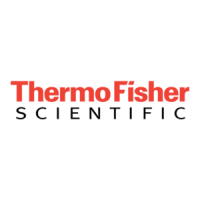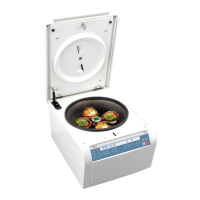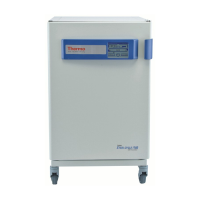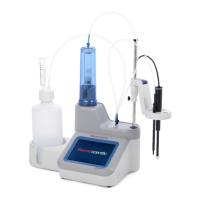Do you have a question about the Thermo Scientific STF55433 and is the answer not in the manual?
Explains various safety symbols used in the manual to indicate hazards and precautions.
Provides crucial guidelines and warnings for safe operation, modification, and use of the furnace.
Lists relevant standards and directives the furnace complies with, including EU, UL, FCC, and ISED.
Details FCC statements and Canadian ISED IC notices regarding electromagnetic emissions and interference.
Provides information on EMC registration for business use in South Korea.
Discusses Proposition 65 (California), REACH, and RoHS directives concerning chemical substances.
States compliance with China's legislative act for controlling pollution from electronic information products.
Highlights key features and advantages of the STF55433 furnace, such as fast heating and energy efficiency.
Describes the furnace's purpose and applications, including laboratory, ashing, and heat treating.
Lists specific uses the furnace is NOT designed for, such as heating food or drying flammable substances.
Presents detailed technical specifications of the STF55433 series tube furnaces in a table format.
Provides instructions on how to unpack the furnace and check for damage, and how to handle returns.
Details factors like corrosive atmospheres and hairline cracks affecting furnace operation and insulation.
Specifies acceptable environmental parameters for installation and storage, including temperature and humidity.
Advises on the use of combustible or inert atmospheres and warns against using combustible gases directly.
Provides guidance on safely lifting and carrying the furnace to prevent injury and damage.
Details safe methods for transporting the furnace, emphasizing proper lifting points and equipment.
Specifies requirements for placing the furnace, including level area and adequate airflow space.
Directs users to wiring diagrams and notes factory wiring of control and furnace.
Explains the 240 VAC operation, power wire requirements, and grounding.
Clarifies that the furnace can operate on 208 VAC with longer heat-up times.
Details how to check thermocouple mounting and wiring connections before initial startup.
Guides on installing the silicon carbide heating elements, including unpacking and packing ceramic wool.
Instructs on installing tube adapters and packing ceramic wool, emphasizing safety.
Provides step-by-step instructions for the initial startup and drying process of the furnace.
Introduces the Eurotherm 3216p controller and its capabilities for temperature control and programming.
Describes the controller's display, including measured values, setpoints, and indicators.
Explains the meaning of various beacons and indicators shown on the controller display.
Details the function of each button on the controller's interface for navigation and operation.
Guides on setting a single temperature setpoint using the controller's interface.
Explains how to select between different setpoints (SP1 and SP2) for flexible operation.
Describes how to set and configure ramp rates for controlled temperature changes.
Details how to switch between temperature units like Celsius (°C) and Fahrenheit (°F).
Explains the auto-tuning process for optimizing PID parameters for accurate temperature control.
Introduces the structure of parameters and operator levels (Level 1 and Level 2).
Describes the parameters accessible and functions available in Operator Level 1 for daily use.
Explains access to advanced parameters in Level 2, typically for trained personnel.
Provides the procedure to gain access to Operator Level 2 using a passcode.
Details how to exit Level 2 and return to the Operator Level 1 interface.
Explains how to apply a user-defined offset for calibration adjustments using PV Offset.
Step-by-step guide to applying a PV Offset value via Level 2 access.
Covers how alarms are indicated and acknowledged, including the ALM beacon and scrolling messages.
Explains how alarms are signaled, confirmed, and how the ALM beacon status changes.
Describes controller behavior and alarms for sensor failures or loop break conditions.
Details how to configure deviation high alarms for over-temperature protection.
Step-by-step guide to setting the deviation alarm threshold (A1.DHi).
Explains the different types of segments used in programming: Target Set Point, Ramp Rate, Step, and Dwell.
Introduces the 3216p controller's capability to store and run programs with multiple segments.
Explains the holdback function which pauses program execution until temperature conditions are met.
Provides steps to create new programs or modify existing ones within the controller.
Describes the 'END.T' parameter options (Dwell, SP2, Reset) that define program termination.
Step-by-step guide to configuring programmer settings like End Type, Ramp Units, and Target Set Points.
Instructions on how to run, hold, and reset programs using the controller interface.
Introduces the Eurotherm 3504 controller, detailing its program storage and configuration capabilities.
Explains the initial startup behavior and modes (AUTO, Manual) of the 3504 controller.
Illustrates the main display of the 3504 controller, identifying key readouts and indicators.
Explains the meaning of various beacons (OP1, MAN, ALM, RUN, HLD, H, A/MAN) on the 3504 controller.
Describes the functions of the operator buttons (Page, Scroll, Lower, Raise) on the 3504 controller.
Details shortcut key combinations for navigating back pages and parameters.
Guides on switching the controller between automatic and manual operation modes.
Explains segment types like Rate and Dwell used in program creation for the 3504 controller.
Defines the 'Step' segment type for instantaneous setpoint changes within a program.
Describes the 'Time' segment type, which defines duration to reach a target setpoint.
Explains the 'GoBack' segment type for repeating program sections a specified number of times.
Details the 'CALL' segment for nesting programs, allowing one program to execute another.
Describes the 'End' segment type used to truncate programs or define termination actions.
Introduces different programmer types: Time to Target and Ramp Rate.
Explains how each segment in this programmer type has a duration and target value.
Describes the ramp rate programmer, specifying segments by rate, dwell, or step.
Lists and explains parameters for program editing, including Program, Segments Used, Cycles, and Segment Type.
Provides instructions on selecting and starting an existing program on the controller.
Guides on editing specific parameters like Target SP and Duration for program segments.
Detailed steps for creating a new program from scratch, setting values for segments.
Explains how to upgrade access from Operator Level 1 to Engineer Level 2.
Re-explains Auto Tune, and provides steps to initiate it via the Control Page.
Instructions for changing display units (e.g., °C to °F) on the controller.
Guides on accessing Level 2 and changing the PV Offset value for calibration.
Details how to access Level 2 and adjust alarm values like Alarm1 Hi and Alarm2 Low.
Instructions for modifying Alarm3 Deviation and Hysteresis values.
Describes the initial operation of the 3216i Over Temperature Controller after power-up.
Explains the functions of the PAGE, SCROLL, DOWN, and UP buttons on the 3216i controller.
Provides steps to acknowledge alarms and turn on the load (heating element).
Instructions for changing display units (e.g., °C to °F) on the 3216i controller.
How to display the current Process Value (PV) on the 3216i controller.
Guides on adjusting the high limit alarm setpoint (A1.HI) for the 3216i controller.
Instructions for changing the hysteresis value for alarms on the 3216i controller.
How to view the peak high temperature recorded by the 3216i controller.
How to reset the peak high temperature reading on the 3216i controller.
Advises checking thermocouple connection if a "S.br" message appears.
How to view or set time units for alarms on the 3216i controller.
How to view the time duration an alarm has been active on the 3216i controller.
Explains the function of Output 4 (OP4) in relation to load power and the excess temperature function.
Discusses the need for adapters to connect the furnace to a PC via RS 485.
Mentions the requirement for data logging software and that Thermo Fisher doesn't provide it.
Lists communication parameters for the 3504 controller (Protocol, Baud Rate, Address).
Lists communication parameters for the 3216 controller (Protocol, Baud Rate, Address).
Provides common checks for connection issues, including cable, power, and configuration.
Guides on replacing the thermocouple, including safety precautions and procedure steps.
Provides instructions for replacing heating elements, emphasizing matching Amp values and safety.
Guides on replacing the control module, including disconnecting power and reattaching wires.
Details the procedure for replacing the solid-state relay, including safety steps.
Provides instructions for replacing the control fuse, including locating the fuse button.
Outlines the procedure for measuring element resistance and current, emphasizing safety.
Provides guidelines for cleaning the furnace interior and exterior surfaces.
Lists common error codes and their probable causes and solutions for the controllers.
Provides solutions for common furnace issues like overheating or failure to heat.
Explains compliance with the EU Waste Electrical & Electronic Equipment Directive and disposal instructions.
Explains various safety symbols used in the manual to indicate hazards and precautions.
Provides crucial guidelines and warnings for safe operation, modification, and use of the furnace.
Lists relevant standards and directives the furnace complies with, including EU, UL, FCC, and ISED.
Details FCC statements and Canadian ISED IC notices regarding electromagnetic emissions and interference.
Provides information on EMC registration for business use in South Korea.
Discusses Proposition 65 (California), REACH, and RoHS directives concerning chemical substances.
States compliance with China's legislative act for controlling pollution from electronic information products.
Highlights key features and advantages of the STF55433 furnace, such as fast heating and energy efficiency.
Describes the furnace's purpose and applications, including laboratory, ashing, and heat treating.
Lists specific uses the furnace is NOT designed for, such as heating food or drying flammable substances.
Presents detailed technical specifications of the STF55433 series tube furnaces in a table format.
Provides instructions on how to unpack the furnace and check for damage, and how to handle returns.
Details factors like corrosive atmospheres and hairline cracks affecting furnace operation and insulation.
Specifies acceptable environmental parameters for installation and storage, including temperature and humidity.
Advises on the use of combustible or inert atmospheres and warns against using combustible gases directly.
Provides guidance on safely lifting and carrying the furnace to prevent injury and damage.
Details safe methods for transporting the furnace, emphasizing proper lifting points and equipment.
Specifies requirements for placing the furnace, including level area and adequate airflow space.
Directs users to wiring diagrams and notes factory wiring of control and furnace.
Explains the 240 VAC operation, power wire requirements, and grounding.
Clarifies that the furnace can operate on 208 VAC with longer heat-up times.
Details how to check thermocouple mounting and wiring connections before initial startup.
Guides on installing the silicon carbide heating elements, including unpacking and packing ceramic wool.
Instructs on installing tube adapters and packing ceramic wool, emphasizing safety.
Provides step-by-step instructions for the initial startup and drying process of the furnace.
Introduces the Eurotherm 3216p controller and its capabilities for temperature control and programming.
Describes the controller's display, including measured values, setpoints, and indicators.
Explains the meaning of various beacons and indicators shown on the controller display.
Details the function of each button on the controller's interface for navigation and operation.
Guides on setting a single temperature setpoint using the controller's interface.
Explains how to select between different setpoints (SP1 and SP2) for flexible operation.
Describes how to set and configure ramp rates for controlled temperature changes.
Details how to switch between temperature units like Celsius (°C) and Fahrenheit (°F).
Explains the auto-tuning process for optimizing PID parameters for accurate temperature control.
Introduces the structure of parameters and operator levels (Level 1 and Level 2).
Describes the parameters accessible and functions available in Operator Level 1 for daily use.
Explains access to advanced parameters in Level 2, typically for trained personnel.
Provides the procedure to gain access to Operator Level 2 using a passcode.
Details how to exit Level 2 and return to the Operator Level 1 interface.
Explains how to apply a user-defined offset for calibration adjustments using PV Offset.
Step-by-step guide to applying a PV Offset value via Level 2 access.
Covers how alarms are indicated and acknowledged, including the ALM beacon and scrolling messages.
Explains how alarms are signaled, confirmed, and how the ALM beacon status changes.
Describes controller behavior and alarms for sensor failures or loop break conditions.
Details how to configure deviation high alarms for over-temperature protection.
Step-by-step guide to setting the deviation alarm threshold (A1.DHi).
Explains the different types of segments used in programming: Target Set Point, Ramp Rate, Step, and Dwell.
Introduces the 3216p controller's capability to store and run programs with multiple segments.
Explains the holdback function which pauses program execution until temperature conditions are met.
Provides steps to create new programs or modify existing ones within the controller.
Describes the 'END.T' parameter options (Dwell, SP2, Reset) that define program termination.
Step-by-step guide to configuring programmer settings like End Type, Ramp Units, and Target Set Points.
Instructions on how to run, hold, and reset programs using the controller interface.
Introduces the Eurotherm 3504 controller, detailing its program storage and configuration capabilities.
Explains the initial startup behavior and modes (AUTO, Manual) of the 3504 controller.
Illustrates the main display of the 3504 controller, identifying key readouts and indicators.
Explains the meaning of various beacons (OP1, MAN, ALM, RUN, HLD, H, A/MAN) on the 3504 controller.
Describes the functions of the operator buttons (Page, Scroll, Lower, Raise) on the 3504 controller.
Details shortcut key combinations for navigating back pages and parameters.
Guides on switching the controller between automatic and manual operation modes.
Explains segment types like Rate and Dwell used in program creation for the 3504 controller.
Defines the 'Step' segment type for instantaneous setpoint changes within a program.
Describes the 'Time' segment type, which defines duration to reach a target setpoint.
Explains the 'GoBack' segment type for repeating program sections a specified number of times.
Details the 'CALL' segment for nesting programs, allowing one program to execute another.
Describes the 'End' segment type used to truncate programs or define termination actions.
Introduces different programmer types: Time to Target and Ramp Rate.
Explains how each segment in this programmer type has a duration and target value.
Describes the ramp rate programmer, specifying segments by rate, dwell, or step.
Lists and explains parameters for program editing, including Program, Segments Used, Cycles, and Segment Type.
Provides instructions on selecting and starting an existing program on the controller.
Guides on editing specific parameters like Target SP and Duration for program segments.
Detailed steps for creating a new program from scratch, setting values for segments.
Explains how to upgrade access from Operator Level 1 to Engineer Level 2.
Re-explains Auto Tune, and provides steps to initiate it via the Control Page.
Instructions for changing display units (e.g., °C to °F) on the controller.
Guides on accessing Level 2 and changing the PV Offset value for calibration.
Details how to access Level 2 and adjust alarm values like Alarm1 Hi and Alarm2 Low.
Instructions for modifying Alarm3 Deviation and Hysteresis values.
Describes the initial operation of the 3216i Over Temperature Controller after power-up.
Explains the functions of the PAGE, SCROLL, DOWN, and UP buttons on the 3216i controller.
Provides steps to acknowledge alarms and turn on the load (heating element).
Instructions for changing display units (e.g., °C to °F) on the 3216i controller.
How to display the current Process Value (PV) on the 3216i controller.
Guides on adjusting the high limit alarm setpoint (A1.HI) for the 3216i controller.
Instructions for changing the hysteresis value for alarms on the 3216i controller.
How to view the peak high temperature recorded by the 3216i controller.
How to reset the peak high temperature reading on the 3216i controller.
Advises checking thermocouple connection if a "S.br" message appears.
How to view or set time units for alarms on the 3216i controller.
How to view the time duration an alarm has been active on the 3216i controller.
Explains the function of Output 4 (OP4) in relation to load power and the excess temperature function.
Discusses the need for adapters to connect the furnace to a PC via RS 485.
Mentions the requirement for data logging software and that Thermo Fisher doesn't provide it.
Lists communication parameters for the 3504 controller (Protocol, Baud Rate, Address).
Lists communication parameters for the 3216 controller (Protocol, Baud Rate, Address).
Provides common checks for connection issues, including cable, power, and configuration.
Guides on replacing the thermocouple, including safety precautions and procedure steps.
Provides instructions for replacing heating elements, emphasizing matching Amp values and safety.
Guides on replacing the control module, including disconnecting power and reattaching wires.
Details the procedure for replacing the solid-state relay, including safety steps.
Provides instructions for replacing the control fuse, including locating the fuse button.
Outlines the procedure for measuring element resistance and current, emphasizing safety.
Provides guidelines for cleaning the furnace interior and exterior surfaces.
Lists common error codes and their probable causes and solutions for the controllers.
Provides solutions for common furnace issues like overheating or failure to heat.
Explains compliance with the EU Waste Electrical & Electronic Equipment Directive and disposal instructions.
| Brand | Thermo Scientific |
|---|---|
| Model | STF55433 |
| Category | Laboratory Equipment |
| Language | English |











